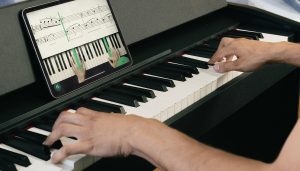“Für Elise” by Ludwig van Beethoven is one of the most famous and recognizable piano melodies in the world. Whenever anybody starts playing the piano, the Für Elise piano notes are one of the things they aspire to learn.
It is believed that Beethoven completed “Für Elise” on 27 April 1810 when he was aged 39, although the piece was not published until 40 years after his death. In 1810 Beethoven was still able to hear some sounds and voices but his deafness was increasingly becoming problematic.
The piece’s official name is Bagatelle No. 25 in A minor but it’s best known for its nickname – “Für Elise”. Who Elise was is unclear… The name comes from an inscription on the front page of Beethoven’s original manuscript, but it’s unclear whether Elise was a piano student of his or a lady Beethoven had romantic feelings for.
Cheat sheet
| Artist | Ludwig van Beethoven |
| Composer | Ludwig van Beethoven |
| Release year | Composed 1810, published 1867 |
| Genre | Classical |
| Difficulty level | Advanced |
| Instrument | Piano |
| Key | A minor |
| Meter | 6/8 |
| Techniques | Right-hand melody, left-hand broken chords |
If you’re learning how to play piano, this tutorial gives you a simple, easy-to-follow guide to Beethoven’s most famous piano tune “Für Elise”. We will cover the techniques required for you to play the Für Elise piano notes as well as the relevant piano chords. And it’s also a great opportunity for you to learn about the background to this famous song with a mysterious history!
Für Elise is probably not the song for you if you’ve only been learning piano for a few weeks; nonetheless, we’re here to give an easy way of playing the Für Elise piano sheet music if you’ve got a bit of piano playing experience behind you.
“Für Elise” chords and progressions
When you start learning the Für Elise piano chords you will need to recall some music theory topics that you have ideally previously covered. Arpeggios and broken chords form an important part of the song – this is when, instead of playing several notes at the same time, you play a chord broken down into one note at a time.
The right hand plays the simple and famous Für Elise notes while the left hand is playing these broken chords.
Für Elise is written in the key of A minor and to begin with you’ll need to know what an A minor chord is and then practice playing it:
A minor is the tonic chord of the Für Elise melody. Next you’ll need to know the dominant chord, which is E major. Try playing it now:


- Fall in love with the music - Learn your favorite songs, at a level suitable for you.
- Enjoy interactive piano lessons - Explore courses covering music theory, technique chords & more.
- Get real-time feedback - Skoove's feedback tells you what went well and what needs practice.

“Für Elise” lesson plan
The following Für Elise piano tutorial will help you find your way around the song, understand the techniques and patterns involved (especially with the broken chords), and learn the famous melody.
Step 1: Listen to the song
It’s always a good idea to listen to the song in full so that you understand what the song should eventually sound like.
Step 2: Practice the Für Elise piano chords
Using the diagrams above to help you find the correct hand position, try practicing the chords. Remember to try them not only as block chords, playing all notes at the same time, but one after each other. This is what you’ll need to be able to do when playing the Für Elise melody. Chord progressions are an important aspect of this song.
Step 3: Try the tune in the right hand only first
First slowly figure out the notes, and take careful note of all the different accidentals in the melody. Don’t worry too much about keeping in time to begin with. Make sure you get the correct starting position, with your right-hand 4th finger over ‘E’ and the middle finger ready to play the ‘D#’.


Right-hand starting position: your 4th finger should be on the ‘E’ and the middle finger ready to play the ‘D#’
Step 4: Learn the left-hand broken chord accompaniment
The left-hand part is playing the broken chords. Take care with the first broken chord as it is quite a stretch for the fingers (low ‘A’ – ‘E’ – high ’A’) and note which finger you should be starting on, as this always makes things a lot easier. You should place your little finger on the low ‘A’ in the left hand, and then the thumb can cover the high ‘A’.


Left-hand starting position: your little finger should be over the low ‘A’ and the thumb should be covering the high ‘A’
Step 5: Play hands together
Once you feel settled and comfortable with some of the large leaps in the left hand and you’re familiar with which sharp needs to go where you’re ready to start playing hands together.
Practice slowly to begin with and really think each note through. Take your time and make sure that the left-hand notes are correctly lined up with the right-hand melody. Looking at the sheet music will help you master this.
When you’re feeling really confident it’s time to play in time. You can use the backing click on the Skoove app to help you with this.
“Für Elise” Practice tips
Here are some great tips and things to remember when you’re starting out learning how to play Für Elise on piano.
- The song is in the key of A minor, which means there are no sharps or flats in the key signature. Even so, do look out for all the accidentals as there are a lot of sharps that sometimes change back to naturals.
- First, start out by learning the right hand, then the left hand, and only when you’ve fully mastered this should you attempt to play with both hands together.
- Practice slowly! Make it easy for yourself and take your time when playing each note, especially if you’re still learning the song.
- Learn to feel your way through the notes in the right-hand piano melody so that you don’t have to look down at the piano keys all the time. This will help you memorize the tune and be able to read piano sheet music faster.
- Remember to play with confidence. Practicing the song using Skoove’s metronome really helps with this!
Interesting fact
There is a strong possibility that the title “Für Elise” came from someone misreading Beethoven’s messy handwriting. The original manuscript looks to be inscribed “Für Therese”. In 1810 Beethoven fell in love with a woman named Therese and asked her to marry him, but he was turned down. So there may never have been an Elise in Beethoven’s life at all!
Conclusion
You have now learned how to play one of the most iconic classical piano melodies ever written. Keep checking that your fingers are in the correct position and that you’re playing a sharp when the music tells you and natural when the music tells you to.
Once you’ve got Beethoven’s Für Elise piano notes under control and firmly in your head, it’s time to move on and learn other things. Fortunately, the Skoove app offers hundreds of other lessons – if you’re after some more classical music why not check out our other lessons on Beethoven’s music or some romantic pieces by Chopin? Or give something completely different a go and try some jazz or rock piano tunes.
Many of Skoove’s online piano lessons have short tutorial guides like this one and the lessons come with real-time feedback on your playing. Sign up for your free trial today!
Author of this blog post:

Sam Girling is a percussion and piano teacher, writer, an researcher based in Münster, Germany and Auckland, New Zealand. He has performed extensively in New Zealand and Europe, lectures on a variety of music history and theory topics, and has published several academic articles and musical scores. Sam has taught music in a variety of contexts, from primary schools through to university level.

















